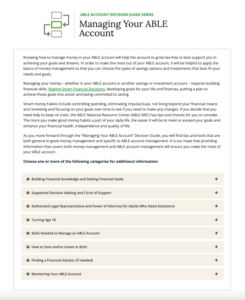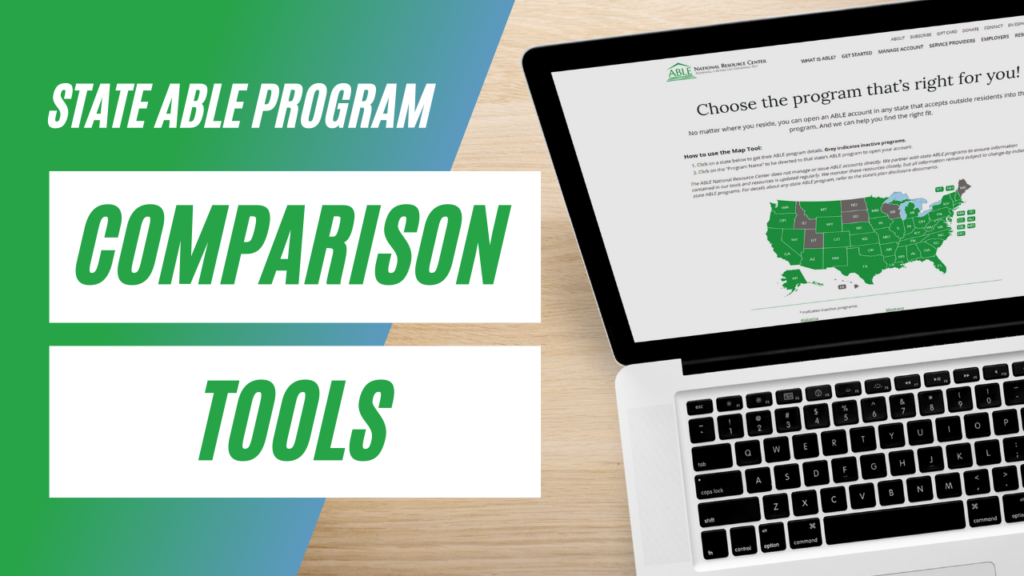The March/April issue of our AchievABLE™ Newsletter contains stories on the following:
- Get Empowered During National Financial Literacy Month
- UPDATE: SSA and Representative Payees (RP)
- Upcoming Webinar: The Racial Wealth Gap: Financial and Other Resources for Historically Black Colleges and Universities (HBCU)
- AchievABLE™ Top 3 Questions
- ABLE Plan Updates
Get Empowered During National Financial Literacy Month
April is National Financial Literacy Month. Nonprofits, government agencies and businesses nationwide celebrate the month by urging all Americans to increase their knowledge of personal finances. The ABLE National Resource Center (ABLE NRC) recognizes Financial Literacy Month as an opportunity to emphasize tools and resources that can help people with disabilities achieve financial stability and wellness.
New! ABLE Decision Guide 7: Managing Your ABLE Account
 The ABLE National Resource Center’s ABLE Decision Guide Series was designed to increase ABLE account owners’ and their families’ understanding of ABLE accounts and to assist in making ABLE decisions. This interactive series of step-by-step guides on specific ABLE topics allows for a variety of pathways and outcomes depending on the ABLE account owner’s circumstances and needs.
The ABLE National Resource Center’s ABLE Decision Guide Series was designed to increase ABLE account owners’ and their families’ understanding of ABLE accounts and to assist in making ABLE decisions. This interactive series of step-by-step guides on specific ABLE topics allows for a variety of pathways and outcomes depending on the ABLE account owner’s circumstances and needs.
Check out the newest – and seventh – ABLE Decision Guide: Managing Your ABLE Account. This guide covers the following activities: (1) Building Financial Knowledge and Setting Financial Goals; (2) Learning about Supported Decision Making and a Circle of Support; (3) Identifying the Skills Needed to Manage an ABLE Account; (4) Understanding Contributions and Withdrawals; and (5) Saving, Investing and Monitoring the ABLE Account.
Check out the first six (6) ABLE Decision Guides covering the following topics:
- Determining ABLE Eligibility
- Finding Funds to Save in Your ABLE Account
- Determining Whether Something Is a Qualified Disability Expense
- Understanding ABLE Account Savings and Public Benefits
- ABLE Accounts for Working People with Disabilities
- Selecting and Opening an ABLE Account
Watch this short video to learn more: Using the ABLE NRC Decision Guides
To discover financial education resources, visit ABLE NRC’s new Financial Education Tools page, which includes links to financial services, games and more!
View Financial Education Tools
Explore Other Financial Wellness Materials:
National Disability Institute (NDI) Financial Education Quick Links
Financial wellness means having financial security and financial freedom of choice in the present and into the future. Below is a list of National Disability Institute’s top financial education wellness links.
- Money Smart – free, comprehensive financial education curriculum created by the Federal Deposit Insurance Corporation (FDIC).
- Money Smart and ABLE Scenario – includes four scenarios for financial inclusion.
- Hands on Banking Quick Reference Guides – resources and tools for financial educators, American Job Centers (AJC), Vocational Rehabilitation (VR) and community-based organizations to support persons with disabilities.
- Money Circle Toolkit – toolkit from the Consumer Financial Protection Bureau that helps start conversations about the feelings and personal relationships that influence money decisions.
Update: SSA and Representative Payees (RP)
The ABLE NRC regularly communicates with the Social Security Administration (SSA) and recently requested clarification on representative payees and ABLE accounts. The Supplemental Security Income (SSI) and Social Security Disability Insurance (SSDI) representative payee policy on benefits saved in the ABLE account is the same as the SSA policy on saving benefits in other types of financial accounts such as checking or saving accounts. However, an ABLE account offers the opportunity for tax-free growth along with up to $100,000 of ABLE account savings not counted towards eligibility or continued eligibility to SSI benefits. No amount of savings, up to the state limit which ranges from $235,000 to $550,000, affects Medicaid or other means-tested benefits.
The ABLE account must be properly titled in order to hold SSI and SSDI benefits saved by the RP. This is true whether the representative payee is a legal guardian or conservator, agent or someone with power of attorney. The SSA beneficiary is the ABLE account owner, but the title must also show the payee as the financial agent with fiduciary interest in the funds. SSA refers to these saved benefits as “conserved funds.” Below are some questions and a summary of SSA responses:
Is ABLE account titling in the name of the beneficiary only acceptable to SSA when a legal guardian opens an ABLE account to save the benefits that remain after paying for current needs?
In all cases – even if the SSA beneficiary has a legal guardian, conservator, authorized legal representative, or has appointed someone with power of authority, the representative payee must title the ABLE account to show that the payee has a fiduciary interest when the ABLE account holds conserved (SSI / SSDI) funds. The account title must show that the beneficiary owns the funds, but has no access to them. Typically, the account must be titled with one of the following:
[Name of Beneficiary] by [Name of Representative payee] or
[Name of Representative Payee] for [Name of Beneficiary]
Note: SSA does not recognize power of attorney as authority to manage another person’s conserved benefits (emphasis added). They only recognize the use of a designated representative payee for handling the beneficiary’s benefits.
If the ABLE plan does not have account titling which meets SSA policy, are there any other options available to an ABLE-eligible individual who does not have a legal guardian or conservator?
Yes. The eligible individual with a disability (or other person as described in IRS current regulations hierarchy of persons in Frequently Asked Questions – Who is eligible to open an ABLE account?) may open an ABLE account for saving and investing.
- The personal needs allowance given to an ABLE account owner by the SSA representative payee may be saved within an ABLE account. It is permissible that a payee may place a personal needs allowance or other personal spending money directly into the ABLE account when the beneficiary agrees. The ABLE account owner has discretion in how the money is spent and the payee should not require that the money be spent in a specific way. The payee must use good judgment in determining whether the beneficiary is using the funds in a way that is consistent with their purpose and is in the beneficiary’s best interest. Another party may not direct how the money is spent. In all cases, ABLE funds must be spent on qualified disability expenses to avoid penalties and interest earnings from being considered income from the ABLE account, which may affect means-tested benefits.
- Money received from other sources such as earnings, veterans benefit payments, unemployment compensation, economic stimulus payments, alimony, pensions, gifts and unearned income may be deposited into an ABLE account. An ABLE account owner who has a representative payee may make the decision to save all or a part of these ABLE funds.
How are ABLE funds are treated: (1) When there is a change of representative payee and conserved funds were saved by the former payee in a properly titled ABLE account? (2) Is there a policy on how conserved funds in the ABLE account are handled when SSA discovers that they were saved in an improperly titled account?
When a payee no longer serves as payee for the SSA beneficiary, he or she is responsible for returning to SSA any funds saved on the beneficiary’s behalf plus interest earned. SSA will reissue the funds to the new payee or directly to the beneficiary if he or she no longer needs a payee. In limited circumstances, a payee may request that SSA allow the transfer of conserved funds directly to the new payee or beneficiary. Payees should contact their local SSA office for further guidance on transferring control of the ABLE account to the new payee or beneficiary directly. SSA may authorize the conserved funds to remain in the ABLE account.
If SSA discovers, or it is reported, that conserved funds are held in an improperly titled account, SSA will require the payee to correct the account title. If the payee is unable or unwilling to correct the account title, SSA will reassess the payee’s suitability to serve. If the ABLE plan does not have options for proper titling, the account may be rolled over to another state ABLE plan that does allow for proper titling.
Comment: The ABLE National Resource Center continues to share feedback we receive with SSA. Please review the webpage: Social Security – Representative Payee Program – Payee and ABLE Accounts for more information or contact us via email at info@ablenrc.org. You may also contact Social Security in various ways, including email to their Support Team.
Upcoming Webinar: The Racial Wealth Gap: Financial and Other Resources for Historically Black Colleges and Universities (HBCU)
Webinar: Tuesday, April 19, 2022 2:00 – 3:30 PM (ET)
 Join this webinar, hosted by the LEAD Center, with speakers from the Consumer Financial Protection Bureau and the U.S. Department of Labor to learn more about the racial wealth gap and financial resources. ABLE National Resource Center Ambassador, Edward Mitchell, is also a featured speaker.
Join this webinar, hosted by the LEAD Center, with speakers from the Consumer Financial Protection Bureau and the U.S. Department of Labor to learn more about the racial wealth gap and financial resources. ABLE National Resource Center Ambassador, Edward Mitchell, is also a featured speaker.
In this webinar, you’ll learn about:
- Unique challenges to economic growth that many Black Americans encounter on their journey to financial well-being
- Review of effective, accessible and inclusive financial education, resources and tools found in DOL’s “Secure Your Financial Future Toolkit” that may be helpful to HBCU students and adults with disabilities
- State-by-state scan of programs, policies, resources, and initiatives that support students with disabilities transitioning to employment during and after the COVID-19 pandemic
- DOL’s Office of Apprenticeship HBCU apprenticeship initiatives
AchievABLE™ Top 3 Questions
1. Can a parent of a child with a disability open an ABLE account and years later use the ABLE funds to purchase a family vehicle or home?
Yes, if the child will be transported in the family vehicle, the ABLE funds may be used to purchase the family vehicle. The funds may also be used to purchase a home that the ABLE account owner will live in.
As always, keep receipts for QDEs for at least three tax filing seasons. Consult an attorney for large purchases if you have a special needs or pooled trust, too, or have questions regarding titling.
2. Can my ABLE funds be used to go on a vacation and to go to a self-advocacy conference for people who have disabilities, too?
A vacation that is not disability-specific would likely not meet the standard for a qualified disability expense, unless it was supported by a doctor’s script. The disability-specific conference costs would clearly be a qualified disability expense.
3. I receive both SSI and SSDI benefits and was told I can only work 20 hours per week; how can I get ahead with my ABLE savings goal with so little earnings?
SSA encourages SSI and SSDI beneficiaries to work to their fullest ability and use work supports that can help the person to maximize their earned income and save regularly. Beneficiaries are encouraged to find a Work Incentive Planning Associate (WIPA) or a Community Work Incentive Counselor (CWIC) to learn about the work supports they can use. Many beneficiaries receive a Ticket to Work (TTW) and decide to assign it to an Employment Network to get help finding a job, boosting their career and using work supports to help them reach their goals towards self-sufficiency. These free resources, including success stories and WISE webinars, are posted on the Social Security Administration Ticket To Work site.
ABLE Plan Updates
Many ABLE plans have submitted updated information for 2022 that is posted in the ABLE NRC Comparison tools. See what updates and options are available for you:
Watch this short video to learn more about Using the ABLE NRC Comparison Tools. Remember, no matter where you reside, you can open an ABLE account in any ABLE plan that accepts out-of-state residents into their program. Find the right fit by using our tools!

